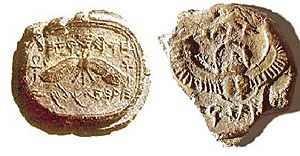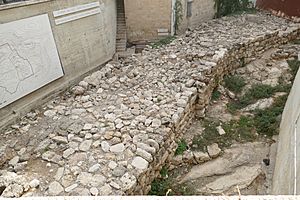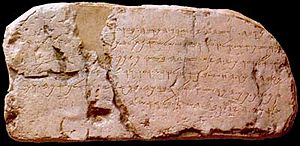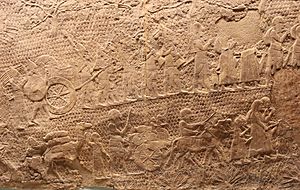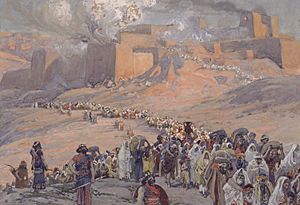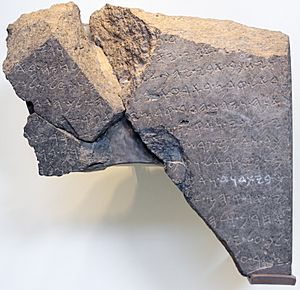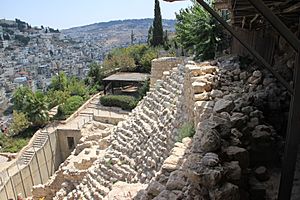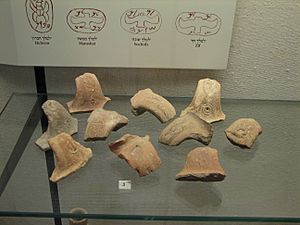Kingdom of Judah facts for kids
Quick facts for kids
Kingdom of Judah
𐤄𐤃𐤅𐤄𐤉
|
|||||||||||
|---|---|---|---|---|---|---|---|---|---|---|---|
| c. 930 BCE–c. 587 BCE | |||||||||||
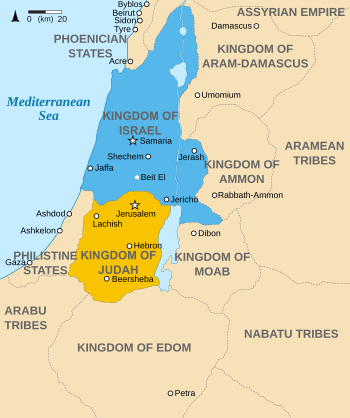
Map of the region in the 9th century BCE, with Judah in yellow and Israel in blue
|
|||||||||||
| Status | Kingdom | ||||||||||
| Capital | Jerusalem | ||||||||||
| Common languages | Biblical Hebrew | ||||||||||
| Religion | Yahwism/early Judaism Canaanite polytheism Folk religion |
||||||||||
| Demonym(s) | Judahite | ||||||||||
| Government | Monarchy | ||||||||||
| King | |||||||||||
|
• c. 931–913 BCE
|
Rehoboam (first) | ||||||||||
|
• c. 597–587 BCE
|
Zedekiah (last) | ||||||||||
| Historical era | Iron Age | ||||||||||
|
• Jeroboam's Revolt
|
c. 930 BCE | ||||||||||
|
• Siege of Jerusalem
|
c. 587 BCE | ||||||||||
|
|||||||||||
| Today part of | |||||||||||
The Kingdom of Judah (Hebrew: יְהוּדָה, Yəhūdā; Akkadian: 𒅀𒌑𒁕𒀀𒀀 Ya'údâ [ia-ú-da-a-a]; Aramaic: 𐤁𐤉𐤕𐤃𐤅𐤃 Bēyt Dāwīḏ, "House of David") was an Israelite kingdom of the Southern Levant during the Iron Age. It was centered in the region of Judea, and its capital was Jerusalem. The other Israelite polity, the Kingdom of Israel, lay to the north. The Jews are named and mostly descendants from the Kingdom of Judah.
The Hebrew Bible depicts the Kingdom of Judah as a successor to the United Kingdom of Israel, a term denoting the united monarchy under biblical kings Saul, David and Solomon and covering the territory of two historical kingdoms, Judah and Israel. However, since the 1980s, skeptical approaches to the Biblical text and the archaeological record led some scholars to believe that the existent archaeological evidence for an extensive kingdom before the late-8th century BCE is too weak and that the methodology used to obtain the evidence is flawed. The Tel Dan Stele, discovered in 1993, has shown that the kingdom, in some semblance, existed by at least the mid-9th century BCE, but it does little to show to what extent.
In the 10th and early 9th centuries BCE, the territory of Judah appears to have been sparsely populated, limited to small rural settlements, most of them unfortified. In the 7th century BCE, the kingdom's population increased greatly, prospering under Assyrian vassalage, despite Hezekiah's revolt against the Assyrian king Sennacherib. After the fall of the Neo-Assyrian Empire in 605 BCE, the ensuing competition between the Twenty-sixth Dynasty of Egypt and the Neo-Babylonian Empire for control of the Levant resulted with the rapid decline of the kingdom. In the early-6th century BCE, Judah was weakened by a series of Babylonian invasions, and in 587/6 BCE, Jerusalem was besieged and destroyed by the second Babylonian king, Nebuchadnezzar II, who subsequently exiled the Judeans to Babylon. The fallen kingdom was then annexed as a Babylonian province.
The Jews who had been deported in the aftermath of the Babylonian conquest of Judah were eventually allowed to return following a proclamation by the Persian king Cyrus the Great that was issued after the fall of Babylon to the Achaemenid Empire. The returned Jewish population in Judah were allowed to self-rule under Persian governance. The Jews fully regained their independence only four-hundred years later, in the aftermath of the Maccabean Revolt.
Biblical narrative
Jeroboam's revolt and the partition of the United Monarchy
According to the biblical account, the United Kingdom of Israel was founded by Saul during the late-11th century BCE, and reached its peak during the rule of David and Solomon. After the death of Solomon circa 930 BCE, the Israelites gathered in Shechem for the coronation of Solomon's son and successor, Rehoboam. Before the coronation took place, the northern tribes, led by Jeroboam, asked the new king to reduce the heavy taxes and labor requirements that his father Solomon had imposed. Rehoboam rejected their petition: “I will add to your yoke: my father hath chastised you with whips, I will chastise you with scorpions" (1 Kings 12:11). As a result, ten of the tribes rebelled against Rehoboam and proclaimed Jeroboam their king, forming the northern Kingdom of Israel. At first, only the tribe of Judah remained loyal to the House of David, but the tribe of Benjamin soon joined Judah. Both kingdoms, Judah in the south and Israel in the north, co-existed uneasily after the split until the destruction of the Kingdom of Israel by Assyria in 722/721.
Relations with the Kingdom of Israel
For the first 60 years, the kings of Judah tried to re-establish their authority over Israel, and there was perpetual war between them. Israel and Judah were in a state of war throughout Rehoboam's 17-year reign. Rehoboam built elaborate defenses and strongholds, along with fortified cities. In the fifth year of Rehoboam's reign, Shishak, pharaoh of Egypt, brought a huge army and took many cities. In the sack of Jerusalem (10th century BCE), Rehoboam gave them all of the treasures out of the temple as a tribute and Judah became a vassal state of Egypt.
Rehoboam's son and successor, Abijah of Judah, continued his father's efforts to bring Israel under his control. He fought the Battle of Mount Zemaraim against Jeroboam of Israel and was victorious with a heavy loss of life on the Israel side. According to the Books of Chronicles, Abijah and his people defeated them with a great slaughter, so that 500,000 chosen men of Israel fell slain, and Jeroboam posed little threat to Judah for the rest of his reign, and the border of the tribe of Benjamin was restored to the original tribal border.
Abijah's son and successor, Asa of Judah, maintained peace for the first 35 years of his reign, and he revamped and reinforced the fortresses originally built by his grandfather, Rehoboam. 2 Chronicles states that at the Battle of Zephath, the Egyptian-backed chieftain Zerah the Ethiopian and his million men and 300 chariots were defeated by Asa's 580,000 men in the Valley of Zephath near Maresha. The Bible does not state whether Zerah was a pharaoh or a general of the army. The Ethiopians were pursued all the way to Gerar, in the coastal plain, where they stopped out of sheer exhaustion. The resulting peace kept Judah free from Egyptian incursions until the time of Josiah, some centuries later.
In his 36th year, Asa was confronted by Baasha of Israel, who built a fortress at Ramah on the border, less than ten miles from Jerusalem. The capital became under pressure, and the military situation was precarious. Asa took gold and silver from the Temple and sent them to Ben-Hadad I, the king of Aram-Damascus, in exchange for the Damascene king cancelling his peace treaty with Baasha. Ben-Hadad attacked Ijon, Dan and many important cities of the tribe of Naphtali, and Baasha was forced to withdraw from Ramah. Asa tore down the unfinished fortress and used its raw materials to fortify Geba and Mizpah in Benjamin on his side of the border.
Asa's successor, Jehoshaphat, changed the policy towards Israel and instead pursued alliances and co-operation with the northern kingdom. The alliance with Ahab was based on marriage. The alliance led to disaster for the kingdom with the Battle of Ramoth-Gilead. He then entered into an alliance with Ahaziah of Israel for the purpose of carrying on maritime commerce with Ophir. However, the fleet that was then equipped at Ezion-Geber was immediately wrecked. A new fleet was fitted out without the co-operation of the king of Israel. Although it was successful, the trade was not prosecuted. He joined Jehoram of Israel in a war against the Moabites, who were under tribute to Israel. This war was successful, and the Moabites were subdued. However, on seeing Mesha's act of offering his own son in a human sacrifice on the walls of Kir-haresheth filled Jehoshaphat with horror, and he withdrew and returned to his own land.
Jehoshaphat's successor, Jehoram of Judah, formed an alliance with Israel by marrying Athaliah, the daughter of Ahab. Despite the alliance with the stronger northern kingdom, Jehoram's rule of Judah was shaky. Edom revolted, and he was forced to acknowledge its independence. A raid by Philistines, Arabs and Ethiopians looted the king's house and carried off all of his family except for his youngest son, Ahaziah of Judah.
Clash of empires
After Hezekiah became the sole ruler in c. 715 BCE, he formed alliances with Ashkelon and Egypt and made a stand against Assyria by refusing to pay tribute. In response, Sennacherib of Assyria attacked the fortified cities of Judah. Hezekiah paid three hundred talents of silver and thirty talents of gold to Assyria, which required him to empty the temple and royal treasury of silver and strip the gold from the doorposts of Solomon's Temple. However, Sennacherib besieged Jerusalem in 701 BCE though the city was never taken.
During the long reign of Manasseh (c. 687/686 – 643/642 BCE), Judah was a vassal of Assyrian rulers: Sennacherib and his successors, Esarhaddon and Ashurbanipal after 669 BCE. Manasseh is listed as being required to provide materials for Esarhaddon's building projects and as one of a number of vassals who assisted Ashurbanipal's campaign against Egypt.
When Josiah became king of Judah in c. 641/640 BCE, the international situation was in flux. To the east, the Neo-Assyrian Empire was beginning to disintegrate, the Neo-Babylonian Empire had not yet risen to replace it and Egypt to the west was still recovering from Assyrian rule. In the power vacuum, Judah could govern itself for the time being without foreign intervention. However, in the spring of 609 BCE, Pharaoh Necho II personally led a sizable army up to the Euphrates to aid the Assyrians. Taking the coastal route into Syria at the head of a large army, Necho passed the low tracts of Philistia and Sharon. However, the passage over the ridge of hills, which shuts in on the south the great Jezreel Valley, was blocked by the Judean army, led by Josiah, who may have considered that the Assyrians and the Egyptians were weakened by the death of Pharaoh Psamtik I only a year earlier (610 BCE). Presumably in an attempt to help the Babylonians, Josiah attempted to block the advance at Megiddo, where a fierce battle was fought and Josiah was killed. Necho then joined forces with the Assyrian Ashur-uballit II, and they crossed the Euphrates and lay siege to Harran. The combined forces failed to capture the city, and Necho retreated back to northern Syria. The event also marked the disintegration of the Assyrian Empire.
On his return march to Egypt in 608 BCE, Necho found that Jehoahaz had been selected to succeed his father, Josiah. Necho deposed Jehoahaz, who had been king for only three months, and replaced him with his older brother, Jehoiakim. Necho imposed on Judah a levy of a hundred talents of silver (about 33⁄4 tons or about 3.4 metric tons) and a talent of gold (about 34 kilograms (75 lb)). Necho then took Jehoahaz back to Egypt as his prisoner, never to return.
Jehoiakim ruled originally as a vassal of the Egyptians by paying a heavy tribute. However, when the Egyptians were defeated by the Babylonians at Carchemish in 605 BCE, Jehoiakim changed allegiances to pay tribute to Nebuchadnezzar II of Babylon. In 601 BCE, in the fourth year of his reign, Nebuchadnezzar attempted to invade Egypt but was repulsed with heavy losses. The failure led to numerous rebellions among the states of the Levant that owed allegiance to Babylon. Jehoiakim also stopped paying tribute to Nebuchadnezzar and took a pro-Egyptian position. Nebuchadnezzar soon dealt with the rebellions. According to the Babylonian Chronicles, after invading "the land of Hatti (Syria/Palestine)" in 599 BCE, he laid siege to Jerusalem. Jehoiakim died in 598 BCE during the siege and was succeeded by his son Jeconiah at an age of either eight or eighteen. The city fell about three months later, on 2 Adar (March 16) 597 BCE. Nebuchadnezzar pillaged both Jerusalem and the Temple and carted all of his spoils to Babylon. Jeconiah and his court and other prominent citizens and craftsmen, along with a sizable portion of the Jewish population of Judah, numbering about 10,000 were deported from the land and dispersed throughout the Babylonian Empire. Among them was Ezekiel. Nebuchadnezzar appointed Zedekiah, Jehoiakim's brother, the king of the reduced kingdom, who was made a tributary of Babylon.
Destruction and dispersion
Despite the strong remonstrances of Jeremiah and others, Zedekiah revolted against Nebuchadnezzar by ceasing to pay tribute to him and entered an alliance with Pharaoh Hophra. In 589 BCE, Nebuchadnezzar II returned to Judah and again besieged Jerusalem. Many Jews fled to surrounding Moab, Ammon, Edom and other countries to seek refuge. The city fell after a siege, which lasted either eighteen or thirty months, and Nebuchadnezzar again pillaged both Jerusalem and the Temple and then destroyed both. After killing all of Zedekiah's sons, Nebuchadnezzar took Zedekiah to Babylon and so put an end to the independent Kingdom of Judah. According to the Book of Jeremiah, in addition to those killed during the siege, some 4,600 people were deported after the fall of Judah. By 586 BCE, much of Judah had been devastated, and the former kingdom had suffered a steep decline of both its economy and its population.
Aftermath
Babylonian Yehud
Jerusalem apparently remained uninhabited for much of the 6th century, and the centre of gravity shifted to Benjamin, the relatively unscathed northern section of the kingdom, where the town of Mizpah became the capital of the new Babylonian province of Yehud for the remnant of the Jewish population in a part of the former kingdom. That was standard Babylonian practice. When the Philistine city of Ashkelon was conquered in 604 BCE, the political, religious and economic elite (but not the bulk of the population) was banished and the administrative centre shifted to a new location.
Gedaliah was appointed governor of the Yehud province, supported by a Babylonian guard. The administrative centre of the province was Mizpah in Benjamin, not Jerusalem. On hearing of the appointment, many of the Judeans who had taken refuge in surrounding countries were persuaded to return to Judah. However, Gedaliah was soon assassinated by a member of the royal house, and the Chaldean soldiers killed. The population that was left in the land and those who had returned fled to Egypt for fear a Babylonian reprisal, under the leadership of Yohanan ben Kareah. They ignored the urging of the prophet Jeremiah against the move. In Egypt, the refugees settled in Migdol, Tahpanhes, Noph and Pathros, and Jeremiah went with them as a moral guardian.
Exile of elites to Babylon
The numbers that were deported to Babylon and that made their way to Egypt and the remnant that remained in the land and in surrounding countries are subject to academic debate. The Book of Jeremiah reports that 4,600 were exiled to Babylonia. The Books of Kings suggest that it was 10,000 and later 8,000.
Yehud under Persian rule
In 539 BCE, the Achaemenid Empire conquered Babylonia and allowed the exiles to return to Yehud Medinata and to rebuild the Temple, which was completed in the sixth year of Darius (515 BCE) under Zerubbabel, the grandson of the second to last king of Judah, Jeconiah. Yehud Medinata was a peaceful part of the Achaemenid Empire until its fall in c. 333 BCE to Alexander the Great.
Religion
The major theme of the Hebrew Bible's narrative is the loyalty of Judah, especially its kings, to Yahweh, which it states is the God of Israel. Accordingly, all of the kings of Israel and many of the kings of Judah were "bad" in terms of the biblical narrative by failing to enforce monotheism. Of the "good" kings, Hezekiah (727–698 BCE) is noted for his efforts at stamping out idolatry (in his case, the worship of Baal and Asherah, among other traditional Near Eastern divinities), but his successors, Manasseh of Judah (698–642 BCE) and Amon (642–640 BCE), revived idolatry, which drew down on the kingdom the anger of Yahweh. King Josiah (640–609 BCE) returned to the worship of Yahweh alone, but his efforts were too late, and Israel's unfaithfulness caused God to permit the kingdom's destruction by the Neo-Babylonian Empire in the Siege of Jerusalem (587/586 BCE).
However, it is now fairly well established among academic scholars that the Books of Kings is not an accurate reflection of religious views in Judah or particularly Israel of the period.
Archaeological record
The formation of the Kingdom of Judah is a subject of heavy debate among scholars, and an acrimonious dispute has emerged between biblical minimalists and biblical maximalists on this particular topic.
While it is generally agreed that the stories of David and Solomon in the 10th century BCE tell little about the origins of Judah, currently, there is no consensus as to whether Judah developed as a split from the United Kingdom of Israel (as the Bible tells) or independently. Some scholars suggested that Jerusalem, the kingdom's capital, did not emerge as a significant administrative center until the end of the 8th century BCE. Before then, the archaeological evidence suggests its population was too small to sustain a viable kingdom. Much of the debate revolves around whether the archaeological discoveries conventionally dated to the 10th century should instead be dated to the 9th century, as proposed by Israel Finkelstein. Recent archaeological discoveries by Eilat Mazar in Jerusalem and Yosef Garfinkel in Khirbet Qeiyafa seem to support the existence of the United Monarchy, but the datings and identifications are not universally accepted.
The Tel Dan Stele shows an historical "House of David" ruled a kingdom south of the lands of Samaria in the 9th century BC, and attestations of several Judean kings from the 8th century BC have been discovered, but they do little to indicate how developed the state actually was. The Nimrud Tablet K.3751, dated c. 733 BCE, is the earliest known record of the name "Judah" (written in Assyrian cuneiform as Ya'uda or KUR.ia-ú-da-a-a).
The status of Jerusalem in the 10th century BCE is a major subject of debate. The oldest part of Jerusalem and its original urban core are the City of David, which does not show evidence of significant Israelite residential activity until the 9th century. However, unique administrative structures such as the Stepped Stone Structure and the Large Stone Structure, which originally formed one structure, contain material culture dated to Iron I. On account of the apparent lack of settlement activity in the 10th century BCE, Israel Finkelstein argues that Jerusalem was then a small country village in the Judean hills, not a national capital, and Ussishkin argues that the city was entirely uninhabited. Amihai Mazar contends that if the Iron I/Iron IIa dating of administrative structures in the City of David are correct, which he believes to be the case, "Jerusalem was a rather small town with a mighty citadel, which could have been a center of a substantial regional polity." William G. Dever argues that Jerusalem was a small and fortified city, probably inhabited only by the royal court, priests and clerks.
A collection of military orders found in the ruins of a military fortress in the Negev dating to the period of the Kingdom of Judah indicates widespread literacy, based on the inscriptions, the ability to read and write extended throughout the chain of command from commanders to petty officers. According to Professor Eliezer Piasetsky, who participated in analyzing the texts, "Literacy existed at all levels of the administrative, military and priestly systems of Judah. Reading and writing were not limited to a tiny elite." That indicates the presence of a substantial educational infrastructure in Judah at the time.
LMLK Seals
LMLK seals are ancient Hebrew seals stamped on the handles of large storage jars dating from reign of King Hezekiah (circa 700 BCE) discovered mostly in and around Jerusalem. Several complete jars were found in situ buried under a destruction layer caused by Sennacherib at Lachish. None of the original seals has been found, but some 2,000 impressions made by at least 21 seal types have been published.
LMLK stands for the Hebrew letters lamedh mem lamedh kaph (vocalized, lamelekh; Phoenician lāmed mēm lāmed kāp – 𐤋𐤌𐤋𐤊), which can be translated as:
- "[belonging] to the king" [of Judah]
- "[belonging] to King" (name of a person or deity)
- "[belonging] to the government" [of Judah]
- "[to be sent] to the King"
Everyday life
According to a 2022 study, traces of vanilla found in wine jars in Jerusalem might indicate that the local elite enjoyed wine flavored with vanilla during the 7-6th centuries BCE. Until very recently, vanilla was not at all known to be available to the Old World. Archeologists suggested that this discovery might be related to an international trade route that crossed the Negev during that period, probably under Assyrian and later, Egyptian rule.
See also
 In Spanish: Reino de Judá para niños
In Spanish: Reino de Judá para niños




